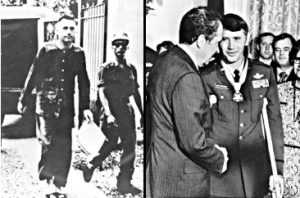 Leo K. Thorsness (February 14, 1932 – May 2, 2017) was born in Walnut Grove, Minnesota. During his youth, he was active in the Boy Scouts and became an Eagle Scout. In January 1951, Leo enlisted in the United States Air Force. He applied for flying school and became an officer and an air force pilot upon graduation from aviation cadet class. He served as a fighter pilot in the Strategic Air Command and Tactical Air Command flying F-84s, F-100s, and F-105s.
Leo K. Thorsness (February 14, 1932 – May 2, 2017) was born in Walnut Grove, Minnesota. During his youth, he was active in the Boy Scouts and became an Eagle Scout. In January 1951, Leo enlisted in the United States Air Force. He applied for flying school and became an officer and an air force pilot upon graduation from aviation cadet class. He served as a fighter pilot in the Strategic Air Command and Tactical Air Command flying F-84s, F-100s, and F-105s.
During the Vietnam War, Thorsness flew Wild Weasel missions over North Vietnam while a member of the 357th Tactical Fighter Squadron. His mission was to seek out and destroy enemy surface to air missile sites which were a danger to Air Force, Navy and Marine pilots. In April 1967, on his 93rd mission, Thorsness was shot down. He became a prisoner of war. Six years later he and his fellow prisoners were released. Upon regaining his freedom, Thorsness received the Medal of Honor, America’s highest award for combat heroism. He had earned this medal during a combat mission over North Vietnam that took place eleven days prior to being shot down.
Retiring from the Air Force as a Colonel, Thorsness worked at Litton Corporate headquarters for six years in Southern California. During his years there, Leo earned a Masters Degree in Systems Management from the University of Southern California. In 1986 he and Gaylee moved to Seattle where he served as a Washington State Senator from 1988 to 1992. Thorsness served as the president of the Congressional Medal of Honor Society. He also spent much of this time speaking to corporations, schools, Boy Scout groups, and military audiences. During his talks, he related the lessons he learned during those six long and difficult years when he was denied his freedom. Leo Thorsness’ book: “Surviving Hell – A POWs Journey,” was published in 2008.
His Medal of Honor reads “For conspicuous gallantry and intrepidity in action at the risk of his life above and beyond the call of duty. As the ilot of an F-105 aircraft, Lt. Col. Thorsness was on a surface-to-air missile suppression mission over North Vietnam. LtCol Thorsness and his wingman attacked and silenced a surface-to-air missile site with air-to-ground missiles, and then destroyed a second surface-to-air missile site with bombs. In the attack on the second missile site, Lt. Col. Thorsness’ wingman was shot down by intensive antiaircraft fire, and the 2 crewmembers abandoned their aircraft. Lt. Col. Thorsness circled the descended parachutes to keep the crewmembers in sight and relay their position to the Search and Rescue Center. During this maneuver, an MIG-17 was sighted in the area. Lt. Col. Thorsness immediately initiated an attack and destroyed the MIG. Because his aircraft was low on fuel, he was forced to depart the area in search of a tanker.
Upon being advised that 2 helicopters were orbiting over the downed crew’s position and that there were hostile MlGs in the area posing a serious threat to the helicopters, Lt. Col. Thorsness, despite his low fuel condition, decided to return alone through a hostile environment of surface-to-air missile and anti-aircraft defenses to the downed crew’s position. As he approached the area, he spotted 4 MIG-17 aircraft and immediately initiated an attack on the MlGs, damaging one and driving the others away from the rescue scene. When it became apparent that an aircraft in the area was critically low on fuel and the crew would have to abandon the aircraft unless they could reach a tanker, Lt. Col. Thorsness, although critically short on fuel himself, helped to avert further possible loss of life and a friendly aircraft by recovering at a forward operating base, thus allowing the aircraft in emergency fuel condition to refuel safely. Lt. Col. Thorsness’ extraordinary heroism, self_sacrifice, and personal bravery involving conspicuous risk of life were in the highest traditions of the military service, and have reflected great credit upon himself and the U.S. Air Force.”
